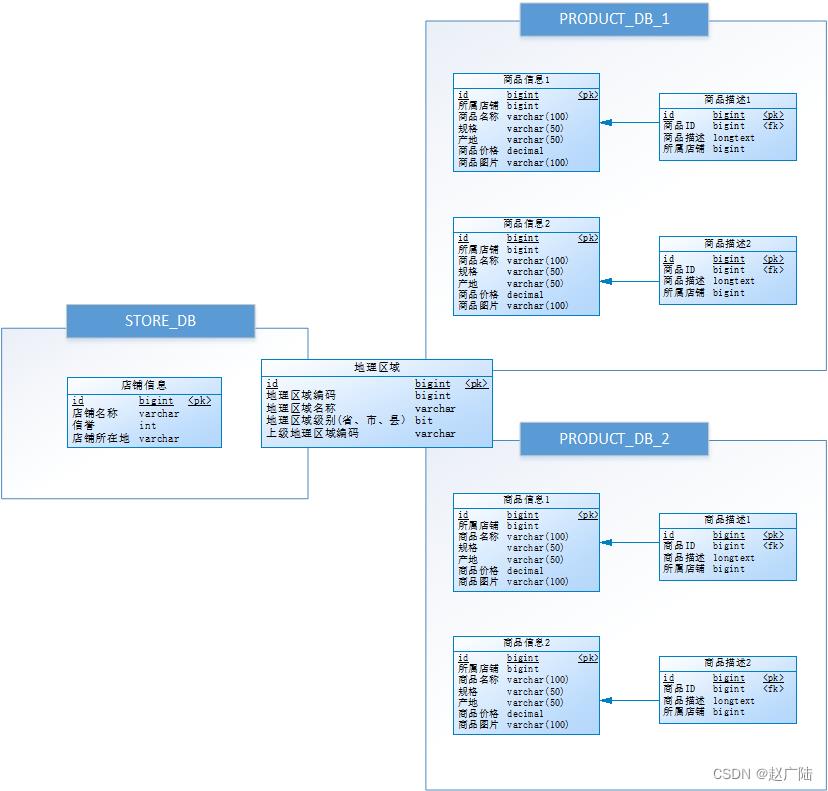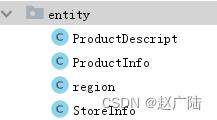Mqsql使用Sharding-JDBC案例实战
Posted 赵广陆
tags:
篇首语:本文由小常识网(cha138.com)小编为大家整理,主要介绍了Mqsql使用Sharding-JDBC案例实战相关的知识,希望对你有一定的参考价值。
目录
1 需求描述
电商平台商品列表展示,每个列表项中除了包含商品基本信息、商品描述信息之外,还包括了商品所属的店铺信息,如下:

本案例实现功能如下:
1、添加商品
2、商品分页查询
4、商品统计
2 数据库设计
数据库设计如下,其中商品与店铺信息之间进行了垂直分库,分为了PRODUCT_DB(商品库)和STORE_DB(店铺库);商品信息还进行了垂直分表,分为了商品基本信息(product_info)和商品描述信息(product_descript),地理区域信息(region)作为公共表,冗余在两库中:

考虑到商品信息的数据增长性,对PRODUCT_DB(商品库)进行了水平分库,分片键使用店铺id,分片策略为店铺ID%2 + 1,因此商品描述信息对所属店铺ID进行了冗余;
对商品基本信息(product_info)和商品描述信息(product_descript)进行水平分表,分片键使用商品id,分片策略为商品ID%2 + 1,并将为这两个表设置为绑定表,避免笛卡尔积join;
为避免主键冲突,ID生成策略采用雪花算法来生成全局唯一ID,最终数据库设计为下图:
要求使用读写分离来提升性能,可用性。
3 环境说明
操作系统: Win10
数据库: mysql-5.7.25
JDK :64位 jdk1.8.0_201
应用框架: spring-boot-2.1.3.RELEASE,Mybatis3.5.0
Sharding-JDBC :sharding-jdbc-spring-boot-starter-4.0.0-RC1
4.环境准备
4.1.mysql主从同步(windows)
参考读写分离章节,对以下库进行主从同步配置:
Myqsql使用Sharding-JDBC分表分库和读写分离

# 设置需要同步的数据库
binlog‐do‐db=store_db
binlog‐do‐db=product_db_1
binlog‐do‐db=product_db_2
4.2.初始化数据库
创建store_db数据库,并执行以下脚本创建表:
DROP TABLE IF EXISTS `region`;
CREATE TABLE `region` (
`id` bigint(20) NOT NULL COMMENT 'id',
`region_code` varchar(50) CHARACTER SET utf8 COLLATE utf8_general_ci NULL DEFAULT NULL COMMENT
'地理区域编码',
`region_name` varchar(100) CHARACTER SET utf8 COLLATE utf8_general_ci NULL DEFAULT NULL
COMMENT '地理区域名称',
`level` tinyint(1) NULL DEFAULT NULL COMMENT '地理区域级别(省、市、县)',
`parent_region_code` varchar(50) CHARACTER SET utf8 COLLATE utf8_general_ci NULL DEFAULT NULL
COMMENT '上级地理区域编码',
PRIMARY KEY (`id`) USING BTREE
) ENGINE = InnoDB CHARACTER SET = utf8 COLLATE = utf8_general_ci ROW_FORMAT = Dynamic;
INSERT INTO `region` VALUES (1, '110000', '北京', 0, NULL);
INSERT INTO `region` VALUES (2, '410000', '河南省', 0, NULL);
INSERT INTO `region` VALUES (3, '110100', '北京市', 1, '110000');
INSERT INTO `region` VALUES (4, '410100', '郑州市', 1, '410000');
DROP TABLE IF EXISTS `store_info`;
CREATE TABLE `store_info` (
`id` bigint(20) NOT NULL COMMENT 'id',
`store_name` varchar(100) CHARACTER SET utf8 COLLATE utf8_general_ci NULL DEFAULT NULL COMMENT
'店铺名称',
`reputation` int(11) NULL DEFAULT NULL COMMENT '信誉等级',
`region_code` varchar(50) CHARACTER SET utf8 COLLATE utf8_general_ci NULL DEFAULT NULL COMMENT
'店铺所在地',
PRIMARY KEY (`id`) USING BTREE
) ENGINE = InnoDB CHARACTER SET = utf8 COLLATE = utf8_general_ci ROW_FORMAT = Dynamic;
INSERT INTO `store_info` VALUES (1, 'XX零食店', 4, '110100');
INSERT INTO `store_info` VALUES (2, 'XX饮品店', 3, '410100');
创建product_db_1、product_db_2数据库,并分别对两库执行以下脚本创建表:
DROP TABLE IF EXISTS `product_descript_1`;
CREATE TABLE `product_descript_1` (
`id` bigint(20) NOT NULL COMMENT 'id',
`product_info_id` bigint(20) NULL DEFAULT NULL COMMENT '所属商品id',
`descript` longtext CHARACTER SET utf8 COLLATE utf8_general_ci NULL COMMENT '商品描述',
`store_info_id` bigint(20) NULL DEFAULT NULL COMMENT '所属店铺id',
PRIMARY KEY (`id`) USING BTREE,
INDEX `FK_Reference_2`(`product_info_id`) USING BTREE
) ENGINE = InnoDB CHARACTER SET = utf8 COLLATE = utf8_general_ci ROW_FORMAT = Dynamic;
DROP TABLE IF EXISTS `product_descript_2`;
CREATE TABLE `product_descript_2` (
`id` bigint(20) NOT NULL COMMENT 'id',
`product_info_id` bigint(20) NULL DEFAULT NULL COMMENT '所属商品id',
`descript` longtext CHARACTER SET utf8 COLLATE utf8_general_ci NULL COMMENT '商品描述',
`store_info_id` bigint(20) NULL DEFAULT NULL COMMENT '所属店铺id',
PRIMARY KEY (`id`) USING BTREE,
INDEX `FK_Reference_2`(`product_info_id`) USING BTREE
) ENGINE = InnoDB CHARACTER SET = utf8 COLLATE = utf8_general_ci ROW_FORMAT = Dynamic;
DROP TABLE IF EXISTS `product_info_1`;
CREATE TABLE `product_info_1` (
`product_info_id` bigint(20) NOT NULL COMMENT 'id',
`store_info_id` bigint(20) NULL DEFAULT NULL COMMENT '所属店铺id',
`product_name` varchar(100) CHARACTER SET utf8 COLLATE utf8_general_ci NULL DEFAULT NULL
COMMENT '商品名称',
`spec` varchar(50) CHARACTER SET utf8 COLLATE utf8_general_ci NULL DEFAULT NULL COMMENT '规
格',
`region_code` varchar(50) CHARACTER SET utf8 COLLATE utf8_general_ci NULL DEFAULT NULL COMMENT
'产地',
`price` decimal(10, 0) NULL DEFAULT NULL COMMENT '商品价格',
`image_url` varchar(100) CHARACTER SET utf8 COLLATE utf8_general_ci NULL DEFAULT NULL COMMENT
'商品图片',
PRIMARY KEY (`product_info_id`) USING BTREE,
INDEX `FK_Reference_1`(`store_info_id`) USING BTREE
) ENGINE = InnoDB CHARACTER SET = utf8 COLLATE = utf8_general_ci ROW_FORMAT = Dynamic;
DROP TABLE IF EXISTS `product_info_2`;
CREATE TABLE `product_info_2` (
`product_info_id` bigint(20) NOT NULL COMMENT 'id',
`store_info_id` bigint(20) NULL DEFAULT NULL COMMENT '所属店铺id',
`product_name` varchar(100) CHARACTER SET utf8 COLLATE utf8_general_ci NULL DEFAULT NULL
COMMENT '商品名称',
`spec` varchar(50) CHARACTER SET utf8 COLLATE utf8_general_ci NULL DEFAULT NULL COMMENT '规
格',
`region_code` varchar(50) CHARACTER SET utf8 COLLATE utf8_general_ci NULL DEFAULT NULL COMMENT
'产地',
`price` decimal(10, 0) NULL DEFAULT NULL COMMENT '商品价格',
`image_url` varchar(100) CHARACTER SET utf8 COLLATE utf8_general_ci NULL DEFAULT NULL COMMENT
'商品图片',
PRIMARY KEY (`product_info_id`) USING BTREE,
INDEX `FK_Reference_1`(`store_info_id`) USING BTREE
) ENGINE = InnoDB CHARACTER SET = utf8 COLLATE = utf8_general_ci ROW_FORMAT = Dynamic;
DROP TABLE IF EXISTS `region`;
CREATE TABLE `region` (
`id` bigint(20) NOT NULL COMMENT 'id',
`region_code` varchar(50) CHARACTER SET utf8 COLLATE utf8_general_ci NULL DEFAULT NULL COMMENT
'地理区域编码',
`region_name` varchar(100) CHARACTER SET utf8 COLLATE utf8_general_ci NULL DEFAULT NULL
COMMENT '地理区域名称',
`level` tinyint(1) NULL DEFAULT NULL COMMENT '地理区域级别(省、市、县)',
`parent_region_code` varchar(50) CHARACTER SET utf8 COLLATE utf8_general_ci NULL DEFAULT NULL
COMMENT '上级地理区域编码',
PRIMARY KEY (`id`) USING BTREE
) ENGINE = InnoDB CHARACTER SET = utf8 COLLATE = utf8_general_ci ROW_FORMAT = Dynamic;
INSERT INTO `region` VALUES (1, '110000', '北京', 0, NULL);
INSERT INTO `region` VALUES (2, '410000', '河南省', 0, NULL);
INSERT INTO `region` VALUES (3, '110100', '北京市', 1, '110000');
INSERT INTO `region` VALUES (4, '410100', '郑州市', 1, '410000');
5 实现步骤
5.1搭建maven工程
(1)搭建工程maven工程shopping,导入资料中基础代码shopping,以dbsharding为总体父工程,并做好
spring boot相关配置。
(2)引入maven依赖
<dependency>
<groupId>org.apache.shardingsphere</groupId>
<artifactId>sharding‐jdbc‐spring‐boot‐starter</artifactId>
<version>4.0.0‐RC1</version>
</dependency>
5.2 分片配置
既然是分库分表,那么就需要定义多个真实数据源,每一个数据库链接信息就是一个数据源定义,如:
spring.shardingsphere.datasource.m0.type = com.alibaba.druid.pool.DruidDataSource
spring.shardingsphere.datasource.m0.driver‐class‐name = com.mysql.jdbc.Driver
spring.shardingsphere.datasource.m0.url = jdbc:mysql://localhost:3306/store_db?useUnicode=true
spring.shardingsphere.datasource.m0.username = root
spring.shardingsphere.datasource.m0.password = root
m0,就是这个真实数据源的名称,然后需要告诉Sharding-JDBC,咱们有哪些真实数据源,如:
spring.shardingsphere.datasource.names = m0,m1,m2,s0,s1,s2
如果需要配置读写分离,还需要告诉Sharding-JDBC,这么多真实数据源,那几个是一套读写分离?也就是定义主从逻辑数据源:
spring.shardingsphere.sharding.master‐slave‐rules.ds0.master‐data‐source‐name=m0
spring.shardingsphere.sharding.master‐slave‐rules.ds0.slave‐data‐source‐names=s0
若我们已经对 m0和s0做了mysql主从同步,那我们需要告诉Sharding-JDBC,m0、s0为一组主从同步数据源,其
中m0为主,s0为从,并且定义名称为ds0,这个ds0就是主从逻辑数据源。
最终配置如下,具体的分库分表策略参考注释内容:
# 真实数据源定义 m为主库 s为从库
spring.shardingsphere.datasource.names = m0,m1,m2,s0,s1,s2
spring.shardingsphere.datasource.m0.type = com.alibaba.druid.pool.DruidDataSource
spring.shardingsphere.datasource.m0.driver‐class‐name = com.mysql.jdbc.Driver
spring.shardingsphere.datasource.m0.url = jdbc:mysql://localhost:3306/store_db?useUnicode=true
spring.shardingsphere.datasource.m0.username = root
spring.shardingsphere.datasource.m0.password = root
spring.shardingsphere.datasource.m1.type = com.alibaba.druid.pool.DruidDataSource
spring.shardingsphere.datasource.m1.driver‐class‐name = com.mysql.jdbc.Driver
spring.shardingsphere.datasource.m1.url = jdbc:mysql://localhost:3306/product_db_1?
useUnicode=true
spring.shardingsphere.datasource.m1.username = root
spring.shardingsphere.datasource.m1.password = root
spring.shardingsphere.datasource.m2.type = com.alibaba.druid.pool.DruidDataSource
spring.shardingsphere.datasource.m2.driver‐class‐name = com.mysql.jdbc.Driver
spring.shardingsphere.datasource.m2.url = jdbc:mysql://localhost:3306/product_db_2?
useUnicode=true
spring.shardingsphere.datasource.m2.username = root
spring.shardingsphere.datasource.m2.password = root
spring.shardingsphere.datasource.s0.type = com.alibaba.druid.pool.DruidDataSource
spring.shardingsphere.datasource.s0.driver‐class‐name = com.mysql.jdbc.Driver
spring.shardingsphere.datasource.s0.url = jdbc:mysql://localhost:3307/store_db?useUnicode=true
spring.shardingsphere.datasource.s0.username = root
spring.shardingsphere.datasource.s0.password = root
spring.shardingsphere.datasource.s1.type = com.alibaba.druid.pool.DruidDataSource
spring.shardingsphere.datasource.s1.driver‐class‐name = com.mysql.jdbc.Driver
spring.shardingsphere.datasource.s1.url = jdbc:mysql://localhost:3307/product_db_1?
useUnicode=true
spring.shardingsphere.datasource.s1.username = root
spring.shardingsphere.datasource.s1.password = root
spring.shardingsphere.datasource.s2.type = com.alibaba.druid.pool.DruidDataSource
spring.shardingsphere.datasource.s2.driver‐class‐name = com.mysql.jdbc.Driver
spring.shardingsphere.datasource.s2.url = jdbc:mysql://localhost:3307/product_db_2?
useUnicode=true
spring.shardingsphere.datasource.s2.username = root
spring.shardingsphere.datasource.s2.password = root
# 主库从库逻辑数据源定义 ds0为store_db ds1为product_db_1 ds2为product_db_2
spring.shardingsphere.sharding.master‐slave‐rules.ds0.master‐data‐source‐name=m0
spring.shardingsphere.sharding.master‐slave‐rules.ds0.slave‐data‐source‐names=s0
spring.shardingsphere.sharding.master‐slave‐rules.ds1.master‐data‐source‐name=m1
spring.shardingsphere.sharding.master‐slave‐rules.ds1.slave‐data‐source‐names=s1
spring.shardingsphere.sharding.master‐slave‐rules.ds2.master‐data‐source‐name=m2
spring.shardingsphere.sharding.master‐slave‐rules.ds2.slave‐data‐source‐names=s2
# 默认分库策略,以store_info_id为分片键,分片策略为store_info_id % 2 + 1,也就是store_info_id为双数的
数据进入ds1,为单数的进入ds2
spring.shardingsphere.sharding.default‐database‐strategy.inline.sharding‐column = store_info_id
spring.shardingsphere.sharding.default‐database‐strategy.inline.algorithm‐expression = ds$‐>
store_info_id % 2 + 1
# store_info分表策略,固定分配至ds0的store_info真实表,
spring.shardingsphere.sharding.tables.store_info.actual‐data‐nodes = ds$‐>0.store_info
spring.shardingsphere.sharding.tables.store_info.table‐strategy.inline.sharding‐column = id
spring.shardingsphere.sharding.tables.store_info.table‐strategy.inline.algorithm‐expression =
store_info
# product_info分表策略,分布在ds1,ds2的product_info_1 product_info_2表 ,分片策略为product_info_id
% 2 + 1,product_info_id生成为雪花算法,为双数的数据进入product_info_1表,为单数的进入product_info_2
表
spring.shardingsphere.sharding.tables.product_info.actual‐data‐nodes = ds$‐>
1..2.product_info_$‐>1..2
spring.shardingsphere.sharding.tables.product_info.table‐strategy.inline.sharding‐column =
product_info_id
spring.shardingsphere.sharding.tables.product_info.table‐strategy.inline.algorithm‐expression =
product_info_$‐>product_info_id % 2 + 1
spring.shardingsphere.sharding.tables.product_info.key‐generator.column=product_info_id
spring.shardingsphere.sharding.tables.product_info.key‐generator.type=SNOWFLAKE
# product_descript分表策略,分布在ds1,ds2的product_descript_1 product_descript_2表 ,分片策略为
product_info_id % 2 + 1,id生成为雪花算法,product_info_id为双数的数据进入product_descript_1表,为单
数的进入product_descript_2表
spring.shardingsphere.sharding.tables.product_descript.actual‐data‐nodes = ds$‐>
1..2.product_descript_$‐>1..2
spring.shardingsphere.sharding.tables.product_descript.table‐strategy.inline.sharding‐column =
product_info_id
spring.shardingsphere.sharding.tables.product_descript.table‐strategy.inline.algorithm‐
expression = product_descript_$‐>product_info_id % 2 + 1
spring.shardingsphere.sharding.tables.product_descript.key‐generator.column=id
spring.shardingsphere.sharding.tables.product_descript.key‐generator.type=SNOWFLAKE
# 设置product_info,product_descript为绑定表
spring.shardingsphere.sharding.binding‐tables[0] = product_info,product_descript
# 设置region为广播表(公共表),每次更新操作会发送至所有数据源
spring.shardingsphere.sharding.broadcast‐tables=region
# 打开sql输出日志
spring.shardingsphere.props.sql.show = true
5.3 添加商品
实体类,参考基础工程:

DAO实现
@Mapper
@Component
public interface ProductDao
//添加商品基本信息
@Insert("insert into product_info(store_info_id,product_name,spec,region_code,price)
value(#storeInfoId,#productName,#spec,#regionCode,#price)")
@Options(useGeneratedKeys = true,keyProperty = "productInfoId",keyColumn = "id")
int insertProductInfo(ProductInfo productInfo);
//添加商品描述信息
@Insert("insert into product_descript(product_info_id,descript,store_info_id) value(#
productInfoId,#descript,#storeInfoId)")
@Options(useGeneratedKeys = true,keyProperty = "id",keyColumn = "id")
int insertProductDescript(ProductDescript productDescript);
service实现,针对垂直分库的两个库,分别实现店铺服务、商品服务
@Service
public以上是关于Mqsql使用Sharding-JDBC案例实战的主要内容,如果未能解决你的问题,请参考以下文章